Your Jama Masjid Delhi exploration begins before you even enter the grand gates. Imagine yourself transported to 17th-century Mughal Delhi, a bustling center of Islamic culture and power. Shah Jahan, the emperor behind the awe-inspiring Taj Mahal, envisioned this very mosque as a symbol of his reign. As you approach the mosque, towering red sandstone walls and four elegant minarets reaching 40 meters will greet you. There are two minarets standing 40m high, one of which can be climbed for amazing views. Take a moment to appreciate the intricate details on the grand eastern gate, the one reserved for the emperor himself
Additional Information:
- Location: Chandni Chowk, Old Delhi
- Nearest Metro Station: Chandini Chowk and Chawdi Bazar
- Entry Fee: No entry fees in Jama Masjid Delhi but a nominal fee for minarets
Visiting Jama Masjid Delhi:
- Open daily from sunrise to sunset.
- Modest clothing covering shoulders and knees is recommended for both men and women.
- Visitors need to remove shoes before entering the prayer hall.
- Photography is permitted within the complex, but be respectful of worshippers.
- Guides are available for hire to provide deeper insights into the mosque’s history and architecture.
The name ‘Jama Masjid’ is not exclusive to this particular mosque. It has been used since the 7th century to refer to the central mosque or Friday mosque of a community. As a result, numerous mosques around the world carry this name or variations of it.
The mosque is situated in the historic city of Shahjahanabad, presently recognized as the locality of Old Delhi. Opposite the mosque, you can find the Red Fort and Sunehri Masjid. Jama Masjid Delhi, being one of the main attractions in Old Delhi, is encircled by several commercial hubs, including the renowned Chandni Chowk. Adjacent to the mosque, you will find the tomb of Abul Kalam Azad, an Indian independence activist.
Architecture:
- Primarily constructed from red sandstone with stunning white marble accents.
- Stands on a 10-meter high platform, offering a commanding view of the surrounding area.
- Features four minarets, each towering 40 meters tall, symbolizing the four righteous caliphs of Islam.
- Three grand gateways provide entry, with the eastern gate being the most ornate, used exclusively by the emperor during his time.
- The spacious courtyard boasts the capacity to hold a staggering 25,000 worshippers.
- Intricate details abound in the interior, featuring beautiful calligraphy, floral designs, and geometric patterns.
Entryways
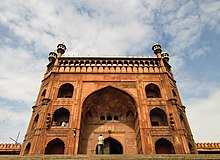
The mosque can be reached through three sandstone gates. The most notable among them is the eastern gate, towering three stories high. Historically, this gate served as the royal entrance, exclusively reserved for the Emperor and his associates. The other two entrances, the northern and southern gates, stand at a height of two stories and were used by the general public. Each gate is accompanied by a sandstone stairway with three sides, featuring white markings to indicate prayer positions. Within the cabinet at the north gate, there is a collection of Muhammad’s relics, including the Quran written on deerskin, a red beard-hair of the prophet, his sandals, and his footprints preserved in a marble block.
Courtyard

The courtyard of the mosque is constructed with red sandstone and is situated in front of the eastern gate. It measures at least 99 meters on each side and has the capacity to hold 25,000 worshippers. At the center, there is a marble ablution tank that is 17 meters long and 15 meters wide. Surrounding the courtyard are open arcades that provide a view of the mosque’s surroundings. Chhatris can be seen at each of the four corners of the courtyard, standing tall above the arcades.
Prayer Hall
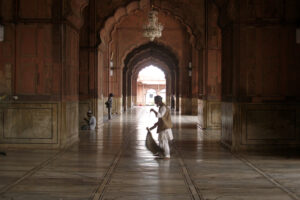
The dimensions of the prayer hall are 61 meters in length and 27 meters in breadth. Its roof is adorned with three marble domes, each topped with golden finials. Positioned at the center of the prayer hall’s facade is a magnificent pishtaq, accompanied by five smaller, cusped archways on either side. Adorning each archway are beautifully crafted calligraphic pieces. Inside the hall, the western qibla wall is adorned with seven mihrabs (prayer niches), corresponding to the seven bays that divide the hall. The central mihrab is exquisitely decorated and covered in marble, with a marble minbar (pulpit) placed to its right. The flooring of the hall is made of white and black ornamented marble, resembling a Muslim prayer mat.
Minarets
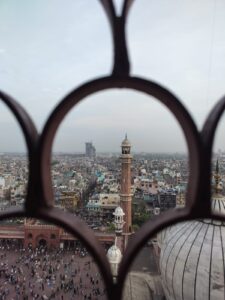
The mosque is adorned with two sandstone minarets on either side of its domes, located at the northeast and southeast corners. These minarets, standing at a height of 40 meters, are elegantly decorated with longitudinal stripes made of white marble. Each minaret comprises 130 steps, providing visitors with viewing galleries at three different levels. The crowning touch of both minarets is a beautiful marble chhatri.
Who built Jama Masjid in Delhi?
The construction of the Jama Masjid Delhi was commissioned by Shah Jahan, the Mughal emperor, and took place from 1644 to 1656. Its inauguration was conducted by Syed Abdul Ghafoor Shah Bukhari, the first Imam. Located in Shahjahanabad, the Mughal capital which is now known as Old Delhi, this grand mosque served as the primary place of worship for the Mughal emperors until the decline of the empire in 1857. The Jama Masjid Delhi held great symbolic significance, representing the power of Islam throughout India, even during the colonial era. Additionally, it played a pivotal role in various political events during British rule. Presently, the mosque remains active and stands as one of the most iconic landmarks in Delhi, closely associated with the spirit of Old Delhi.
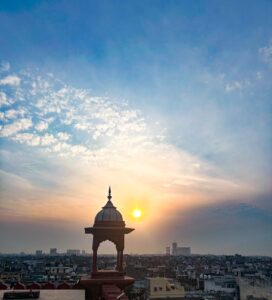
The construction of the mosque took place during the reign of Shah Jahan, making it one of the final architectural marvels commissioned by the emperor. Following its completion, it functioned as the official mosque for the Mughal rulers until the decline of the Mughal dynasty. The Friday sermon, known as khutba, was delivered by the Mughal emperor himself, reinforcing his authority. This mosque stood as a powerful emblem of Mughal dominance in India, holding great political significance. Moreover, it played a crucial role as a hub of social activity in Shahjahanabad, fostering interactions among people from various backgrounds and transcending societal barriers.
Significance:
- A major center for Islamic worship and religious gatherings, especially Friday prayers.
- A UNESCO World Heritage Site, recognized for its historical, cultural, and architectural importance.
- A popular tourist destination in Delhi, attracting visitors with its grandeur, intricate details, and historical significance.
Beyond the Mosque:
While Jama Masjid Delhi is the main attraction, here are some interesting places to explore nearby:
- Red Fort: A majestic Mughal fort located opposite Jama Masjid Delhi, showcasing Mughal power and history.
- Chandni Chowk: A bustling old market area known for its delicious street food, vibrant atmosphere, and variety of shops.
- Kinari Bazaar: A market specializing in traditional clothing, wedding wear, and textiles.
Can girls visit Jama Masjid Delhi?
Female visitors are allowed to visit Jama Masjid Delhi without any restrictions.
Can non Muslims go to Jama Masjid Delhi?
Non-Muslims are permitted to visit the Jama Masjid only when it is not prayer time. It is advisable for non-Muslims to refrain from visiting on Fridays, the Islamic holy day, as well as during Islamic festivals, as the mosque tends to be very crowded during these times.
Is Jama Masjid free?
Yes, entry to Jama Masjid Delhi is free but there are nominal charges for going up in minaret.
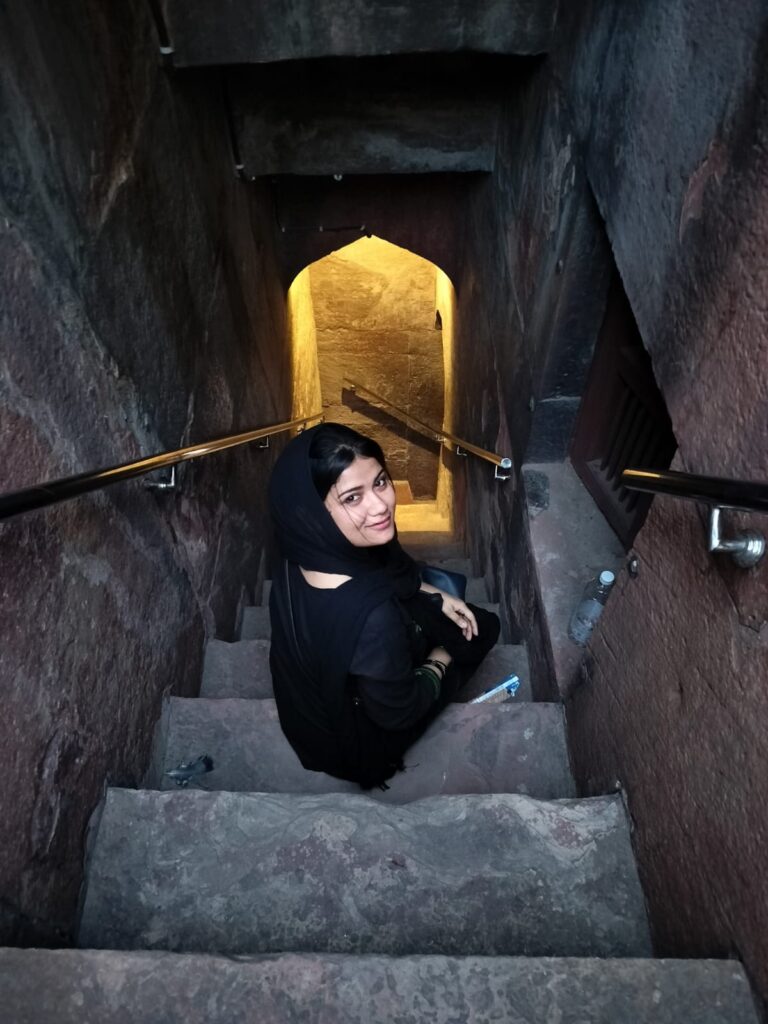
3 thoughts on “Jama Masjid Delhi: A Grand Mughal Mosque”
Pingback: Delhi Tourist Places - Trippy Tales
Pingback: Daryaganj Book Market: A New Chapter at Mahila Haat - Trippy Tales
Pingback: Plan a Day Trip to Red Fort, Jama Masjid, Daryaganj Book Market and Chor Bazaar - Trippy Tales